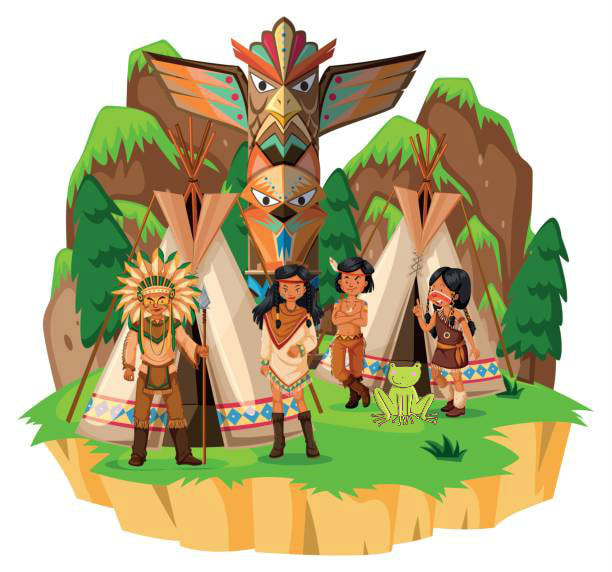There's a lot more I could say on this subject but, really, the focus of my blog today is to enlighten your mind with a few interesting facts on the Indigenous peoples (Native Americans) who were the original settlers of the land.
1. The term “Native American” does not usually refer to Native Hawaiians or Alaskan Natives, such as Aleut, Yup’ik, or Inuit peoples. Most indigenous people in the U.S. use “American Indian,” while most indigenous people in Canada use “First Nations.” “Native Americans” or “indigenous Americans” are often used for people in both countries.
2. Ishi (c. 1860–1916) is widely known as the “last wild Indian” in America. He lived most of his life outside modern culture after his tribe, the Yahi (of the Yana group) became extinct in the late 1800s because of the California Gold Rush. He lived alone in the wilderness after his family died. In 1911, starving and with nowhere to go, he walked out of the wilderness into the town of Oroville, where he would be later studied by anthropologists.
3. The Sequoia tree is named in honor of the Cherokee leader Sequoyah, who helped his people develop an alphabet.
4. Native Americans and First Nations people speaking a language of the Algonquian group were the first to meet English explorers and, consequently, many words from these languages entered English—for example, caribou (“snow-shoveler”), chipmunk (“red squirrel”), moccasin, moose, muskrat, opossum (“white dog”), papoose (“baby”), pecan (“nut”), powwow (“to dream, to have a vision”), raccoon, skunk (“to urinate” + “fox”), squaw, toboggan, totem, wigwam, and woodchuck.
5. Half of the names of U.S. states are derived from Amerindian words, such as Arizona, Connecticut, Kentucky, and Missouri.
7. Many Native American words have entered the English language, such as chia, chili, chocolate, coyote, guacamole, mesquite, peyote, shack, tamale, tomato, abalone, bayou, cannibal, Chinook, manatee, poncho, and potato.
8. The Indian Citizenship Act (Snyder Act) of 1924 granted full U.S. citizenship to America’s indigenous peoples. It was enacted in part due to the recognition of thousands of Native Americans who served in WWI.
9. Native Americans have been living on the American continent since about 12,000 B.C. They were not a single nation but a rich variety of cultures, peoples, and languages. Some historians believe people have been living in South America for more than 30,000 years.
10. In the early 1600s, five tribes who were former enemies formed the Iroquois Confederacy. An all-male council who was elected for life made decisions; however, women had the right to fire any councilor.
11. Benjamin Franklin, a coauthor of the Constitution, thought the idea of a government like the Iroquois Confederacy could be used by the English colonies. The eagle on the U.S. shield is the Iroquois bald eagle—also a symbol for the Iroquois.
12. The word “Sioux” was adopted by French explorers who picked it up from the Chippewa tribe. “Sioux” is the Chippewa word for “enemy,” who were the Lakota people. So the Sioux are, in reality, the same as the Lakota, a name that means, “Where the people of peace dwell.”
13. The Choctaw, Cherokee, Creek, Chickasaw, and Seminole tribes were called the “Five Civilized Tribes” by early white settlers. They were considered more civilized because of the similarities between their cultures and those of the Europeans, such as planned villages and farms—and some Native Americans were wealthy enough to even own slaves.
14. The Nez Perce people helped Lewis and Clark explore the Northwest Territory. They built canoes for them, drew maps of the rivers, and helped them reach the Pacific.
15. Native Americans would use porcupine hairs to make hairbrushes. Sometimes a stick was cut into the right shape and frayed at the edges to make a toothbrush.
16. The Iroquois celebrated a winter festival similar to trick-or-treating. A small group of teenagers was led singing and dancing around the village by an older woman. They stopped outside people’s houses and waited for presents to be brought out to them.
17. Some Native Americans created a “Cry Shed,” which was built of earth and represented the troubles and wishes of the community. It was set on fire, and as it burned, it was believed misfortunes were blown away on the wind and hopes were carried to the spirit world.
18. Native Americans of the Northwest like the Haida built totem poles as tall as 40 feet outside their homes to advertise their families’ status. The pole would usually depict animals or birds that were special to the family. Totem poles were also built as a memorial to a family’s ancestors. Christians mistakenly thought that totem poles were statues of the gods.
19. Over 24,000 Native Americans served during WWII. One of the most notable groups was the Navajo Code Talkers, who were a special group of volunteers who created an unbreakable secret code.
20. Most scientists believe that the ancestors of today’s Native Americans migrated from Asia to North America. It is purported that as many as 20,000 years ago, they walked across a land bridge that existed at today’s Bering Strait
And a bonus fact...
21. According to the U.S. Census Bureau, the largest tribal groups in the U.S are the Cherokee, Navajo, Chippewa (Ojibwa), Apache, Choctaw, Iroquois, Lumbee, Pueblo, and Sioux (Lakota). There are about 4.5 million people of Native American and Alaska Native heritage in the U.S. This group makes up about 1.5% of the U.S. population.
I learned a lot about the indigenous people of the US while writing this blog. I hope you found it as educational and as interesting as I did.
Tomorrow is National Grouch Day and I have prepared some useful tips on how best to deal with the grouch(es) in your life. Please stop by tomorrow for that one. Until then, I wish you a Happy Native American Day.
PEACE.

 RSS Feed
RSS Feed